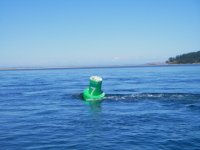thataway
Well-known member
- Joined
- Nov 2, 2003
- Messages
- 21,701
- Reaction score
- 74
- C Dory Year
- 2007
- C Dory Model
- 25 Cruiser
- Hull Identification Number
- DOR25652A707
- Vessel Name
- thataway
There are a number of constantly adjustable pitch props--not aware of any for outboards however. The boats we built had a Sabb engine with only a dog clutch, and a constantly adjustable pitch prop, from full feather to full flat fore and aft--in both forward and reverse. This was accomplished with a hollow prop shaft, and an inner shaft, which could be worked back and forth, catching ears on the inner aspects (inside the hub boss) of the prop--thus changing the pitch when running. I would dock with the engine running at 1000 RPM--and then just use the pitch to walk the boat sideways, or move forward or aft. The design of this prop system is close to, if not more than 100 years old. Some very large props in commercial applications use exactly this same technique. There are some available for the largest of cargo ships.
In outboard props, those which flex, may work well, but are never quite as effecient as a well designed and specificated prop for that engine and specific application.
In outboard props, those which flex, may work well, but are never quite as effecient as a well designed and specificated prop for that engine and specific application.


